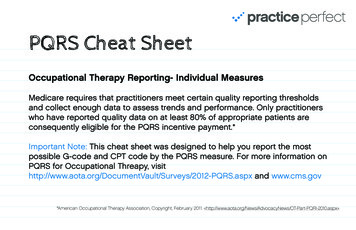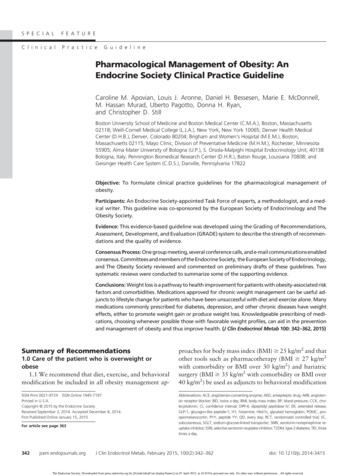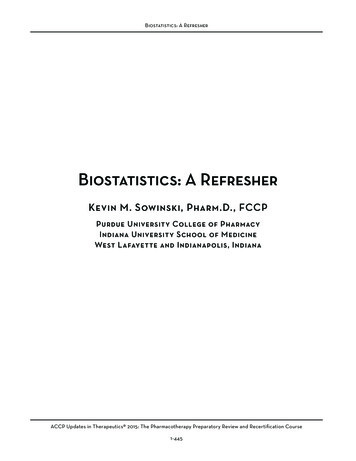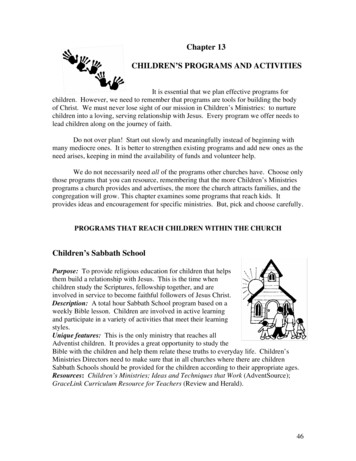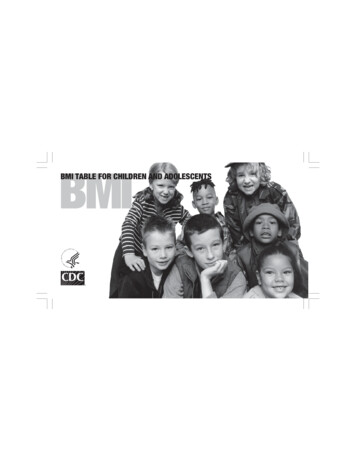
Transcription
BMI TABLE FOR CHILDREN AND ADOLESCENTSBMI
BMIBMI TABLE FOR CHILDREN AND ADOLESCENTSThe Body Mass Index (BMI) value hasbeen calculated and is presented in thistable for selected heights and weights forchildren and adolescents 2 to 20 years ofage. BMI is defined as weight in kilogramsdivided by height in meters squared.U.S. Department of Health and Human ServicesCenters for Disease Control and Preventionhttp://www.cdc.gov/growthchartsHOW TO USE THIS TABLE1Find the page containing the child’s height and weight using the height and weightranges listed in the table of contents or in the upper left corner of each page.Some heights and weights appear on more than one page, so be sure bothmeasurements are within the range shown on the page.2Find the point where the child’s height and weight intersect. This value representsthe child’s BMI. Whenever a child’s specific height or weight is not listed, round tothe closest number in the table (see “Rounding Rule” on next page).3Plot the BMI value on the BMI-for-age chart to determine whether the child iswithin the normal growth pattern, overweight, obese, or underweight.Note: In the table, the increments between height and weight gradually increase asheight and weight measurements increase.
ROUNDING RULE FOR WEIGHT AND HEIGHT MEASUREMENTSBMIWhenever a child’s specific height orweight measurement is not listed, roundto the closest number in the table. If theheight or weight measurement is at themidpoint or equal distance between twounits, round down to the previous unit.The numbers in the table for both Englishand metric measurements are expressedin decimals. For all English measurements.5 is equal to 1/2 inch or pound.If a child’s weight is 261/4 pounds (11.9 kg), it is equidistant between26 and 261/2 (11.8 and 12 kg); therefore, the weight should berounded down to 26 pounds (11.8 kg).If a child’s weight is 263/4 pounds (12.1 kg), it is equidistant between261/2 and 27 (12 and 12.2 kg); therefore, the weight should berounded down to 261/2 pounds (12 kg).If a child’s weight is 603/4 pounds (27.6 kg), it is between 60 and61 pounds (27.2 and 27.7 kg); therefore, the weight should be roundedto the closest whole number or 61 pounds (27.7 kg).EXAMPLEDavid is 301/2 months of age, is 343/4 inches tall, and weighs 261/4pounds. Using the rounding rule, his standing height should be roundedto 341/2 inches, and his weight should be rounded to 26 pounds. Todetermine David’s BMI, find the page containing his standing roundedheight and weight, then find the point where the two intersect. David’sBMI is 15.4, as noted on page 2 of this BMI Table.
ContentsInches . Pounds . Page29–35.5" .29–35.5" .36–39.5" .29–36" .36.5–43.5" .29–36" .36.5–43" .43.5–47" .29.5–36.5" .37–43.5" .44–50" .31.5–38.5" .39–45.5" .18–23.5 lbs. . 124–29.5 lbs. . 224–29.5 lbs. . 330–35.5 lbs. . 430–35.5 lbs. . 536–41.5 lbs . 636–41.5 lbs . 736–41.5 lbs . 842–47.5 lbs . 942–47.5 lbs . 1042–47.5 lbs . 1148–53.5 lbs . 1248–53.5 lbs . 13Inches . Pounds . PageInches . Pounds . Page46–53" .33–40" .40.5–47" .47.5–56" .35–42" .42.5–50" .51–61" .38.5–45.5" .46–57" .58–66" .41.5–49" .50–63" .64–71" .44–54" .55–68" .69–76" .47–60" .61–74" .75–78" .52–65" .66–78" .56–69" .70–78" .60–73" .74–78" .64–78" .68–78" .48–53.5 lbs . 1454–59.5 lbs . 1554–59.5 lbs . 1654–59.5 lbs . 1760–71 lbs . 1860–71 lbs . 1960–71 lbs . 2072–83 lbs . 2172–83 lbs . 2272–83 lbs . 2384–95 lbs . 2484–95 lbs . 2584–95 lbs . 2696–107 lbs . 2796–107 lbs96–107 lbs108–128 lbs108–128 lbs108–128 lbs130–152 lbs130–152 lbs154–176 lbs154–176 lbs178–200 lbs178–200 lbs202–224 lbs226–250 lbs. 28. 29. 30. 31. 32. 33. 34. 35. 36. 37. 38. 39. 40
29–35.5" and 18–23.5 .115.615.214.714.313.913.513.1
29–35.5" and 24–29.5 17.416.916.5
36–39.5" and 24–29.5 013.613.3
29–36" and 30–35.5 .621.020.419.819.3
36.5–43.5" and 30–35.5 514.113.813.513.2
29–36" and 36–41.5 .224.523.823.222.5
36.5–43" and 36–41.5 17.416.916.516.215.8
43.5–47" and 36–41.5 13.613.313.015.415.114.714.414.113.813.513.2
29.5–36.5" and 42–47.5 .833.732.631.630.729.828.928.127.326.525.825.1
37–43.5" and 42–47.5 .418.918.518.117.6
44–50" and 42–47.5 .916.516.115.815.415.114.814.513.913.4
31.5–38.5" and 48–53.5 4.533.532.531.630.729.829.028.227.526.726.025.4
39–45.5" and 48–53.5 .319.919.419.018.618.2
46–53" and 48–53.5 3.317.817.417.016.716.315.715.014.513.913.4
33–40" and 54–59.5 729.028.227.526.826.1
40.5–47" and 54–59.5 1.120.720.219.819.318.9
47.5–56" and 54–59.5 3.713.218.518.217.416.716.115.514.914.313.813.3
35–42" and 60–71 2.832.031.230.429.729.028.3
42.5–50" and 60–71 3.122.622.121.720.820.0
51–61" and 60–71 .4
38.5–45.5" and 72–83 28.828.2
46–57" and 72–83 1.620.820.019.318.618.0
58–66" and 72–83 .514.113.613.217.316.816.215.715.214.714.213.813.4
41.5–49" and 84–95 .930.229.629.027.8
50–63" and 84–95 9.919.218.617.917.416.8
64–71" and 84–95 3.116.315.815.314.914.414.013.613.2
44–54" and 96–107 .825.8
55–68" and 96–107 0.219.619.018.417.817.316.816.3
69–76" and 96–107 4.914.514.113.713.413.0
47–60" and 108–128 ge30WEIGHTKG49.0LB .424.634.633.332.030.929.728.727.726.825.925.0
61–74" and 108–128 TKG49.0LB .518.918.417.917.416.916.4
75–78" and 108–128 age32WEIGHTKG49.0LB .913.513.214.514.113.813.414.714.414.013.615.014
BMI. ROUNDING RULE FOR WEIGHT AND HEIGHT MEASUREMENTS. Whenever a child’s specific height or weight measurement

